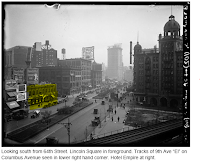"I was traveling familiar ground. During the previous summer I had made the journey on a California motor bicycle to Reno, Nevada, and knew that crossing the Sierras, even when helped by a motor, was not exactly a path of roses. But it was that tour, nevertheless, that fired me with desire to attempt this longer journey - to become the first motorcyclist to ride from ocean to ocean."
G.A.Wyman, "Over the Sierra's and Through the Snow Sheds", The Motorcycle Magazine, June, 1903
Wyman traveled the roads east of Sacramento that followed the Central Pacific "Transcontinental" Railroad. The gradual sloping countryside would increase in elevation as he passed through the town of Rocklin. By the time he got to Auburn his motorcycle was "chugging" along, laboring under him as he rode up ever increasing grades. By riding over the roads that followed the railroad tracks, he would always know where he was and what was up ahead. The Railway was the dominate transportation artery across America in 1903. Wyman was using the "Official Guide" listing all the stations, section houses and other official CPRR points from San Francisco to Omaha, NE. It listed the railroad miles from San Francisco and the elevation. Wyman would refer to it many times along his journey.
 |
| 1902 USGS Topo Map |
 |
| Wyman at Colfax Depot |
We are pleased to announce!
The City of Colfax, California, had joined The George A. Wyman Memorial Project as the hosting authority for the 518.4 Colfax RON Wyman Waypoint location. The City Council approved mounting of the Wyman Memorial Journey plaque and Wyman Waypoint sign at the City owned park between the Colfax Depot and the old Gillen Hotel building. The Colfax Area Historical Society will display the Wyman Colfax site narrative, Wyman Waypoint Poster and photographs inside the Colfax Passenger Depot museum.
The dedication ceremony has tentatively been set for May 18, 2016; the anniversary of Wyman's over night stay in Colfax. Tom and Helen Austin are the Wyman Memorial Plaque Sponsors for the 518.4 Colfax RON location and have graciously agreed to represent the Project at the dedication.
The George A. Wyman Memorial Project is grateful to the City of Colfax for joining the Project and enthusiastically embracing the Wyman story. Working together, we are....
"Linking the Past to the Present to Enrich the Future"





